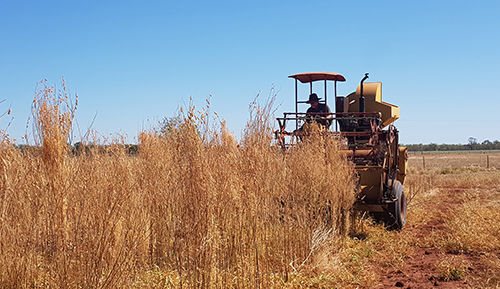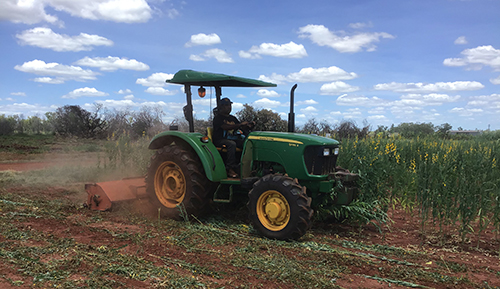Sunn Hemp (Crotolaria Juncea) evaluation Trial: Results of 2020 Demonstration Site
Most soils in the Northern Territory have a weak structure and low organic matter and are subject to further structural degradation from wet season rains if not protected against erosion. Growing cover crops at the beginning of the wet season, before the cash crop in the dry season, plays an integral part in best soil management practice.
A tropical Asian plant that has become a very popular cover crop is Sunn Hemp, due to its ability to fix nitrogen, as it is a legume, and is fast growing. Despite its common name, Sunn Hemp is Crotalaria juncea which is not a ‘Hemp’ at all but is known as such because of its bright yellow flowers. A trial evaluating the potential of Global Sunn™ as a cover crop is currently underway at the Katherine Research Station under the oversight of the Department of Industry, Tourism and Trade’s (DITT) Research Horticulturist, Danilo Guinto, Technical Officers Heshan Jayasekara and Frank Lunguna.
The trial evaluated biomass yield, soil nematode suppressing ability, and seed production potential. The crop was grown on two experimental plots; a 0.2ha plot designated as a cover crop looking at basic agronomic growth parameters and soil nematode suppressing actions (Cover crop trial), and a 0.1ha plot for seed production looking at seed yields from three different topping treatments (seed production trial).
The Global Sunn™ seeds were inoculated with rhizobia provided by AGF Seeds prior to planting and were sown at 2-3cm deep with a grain drill in early 2020. The seeding rate for the cover crop trial was 40kg/ha in rows spaced 14cm apart. The seeding rate for the seed production trial was 4kg/ha with row spacing of 1m. An initial application of NPK fertilizer was applied at 200kg/ha at the same time as seed drilling on both trial plots.
Once established, Global Sunn™ is considered to be a drought-tolerant crop. The cover crop trial did not receive any irrigation and was mulched on 20 March (Figure 1). However, for the seed production trial, light drip irrigation was applied for one hour (about 1.4mm) during dry and hot days. During the growing period (30 January to 8 July), the crop received 195mm of rain and 92mm of irrigation.
Pruning the top of the stems (topping) induces the development of lateral branches, thereby increasing the site for flower and pod development. This practice has been previously shown to increase seed yield. For the seed production trial, the plot was divided equally into three blocks for topping treatments; control (no topping), topping at 20 days after planting (DAP), and topping at 40 DAP.
Figure 1. Surface mowing of the sunn hemp cover crop using a mulcher, 20 March
Initial results
Chemical analysis of soil samples before sowing and two weeks after incorporation showed no change in the amount of NH4+-N (1.0mg/kg) and NO3--N (14.0mg/kg), indicating very low nitrogen mineralization from the surface mulching of the cover crop. Average dry matter yield measured prior to mulching was around 1.1t/ha, which is low compared to the 6.8t/ha yield for pearl millet sown at the same time. Similarly, its nitrogen contribution (through root nodule fixation by Rhizobia and plant soil N uptake) was relatively low, estimated at only 27kg N/ha. The 30cm top layer showed no significant levels of soil borne pathogens (fungi, nematodes) prior to sowing and two weeks after mulching.

Figure 2. Harvesting of the sunn hemp seed crop, 8 July3
With regards to seed production, even though the dry matter yields obtained with the topping treatments were more than double that of the control treatment, the differences in the seed yields obtained between control and topped treatments were not statistically significant. The seed yields were 115kg/ha, 93kg/ha, 114kg/ha in control, topped at 20 DAP and topped at 40 DAP, respectively.
This preliminary trial exhibited some potential for Global Sunn™ as a cover crop in the NT. However, further field trials need to investigate the effect of variety, seeding rate, fertilizer, soil moisture, and other variables on nitrogen fixation and dry matter yield.

